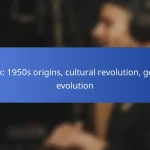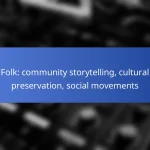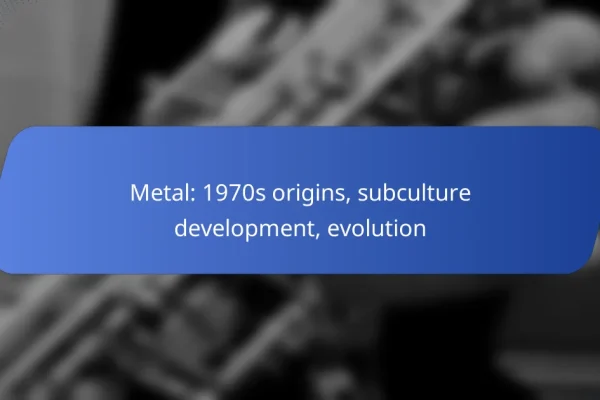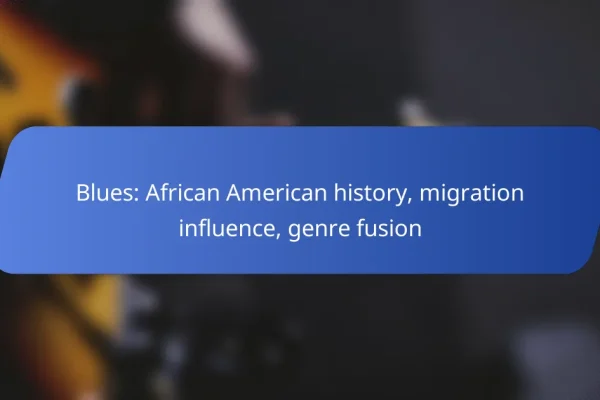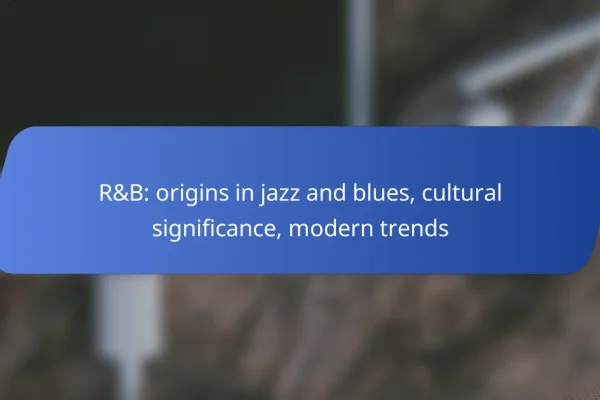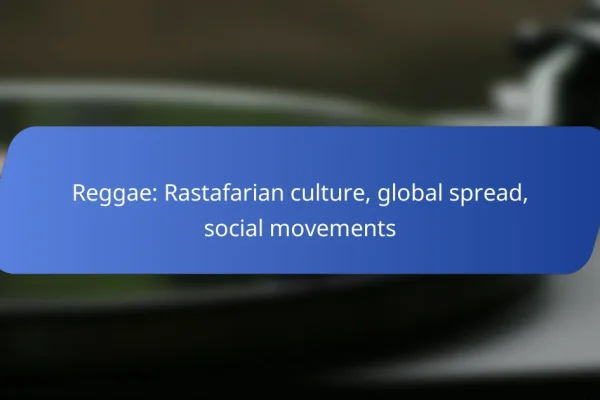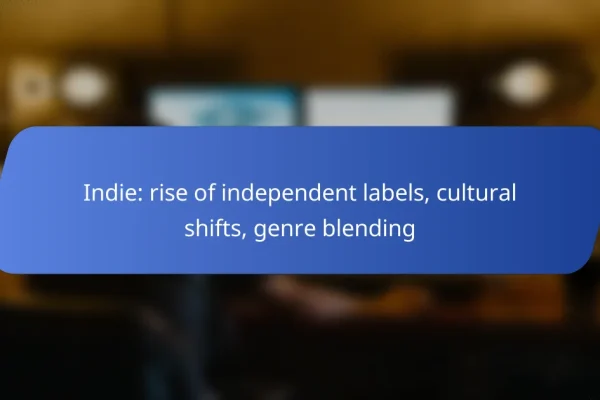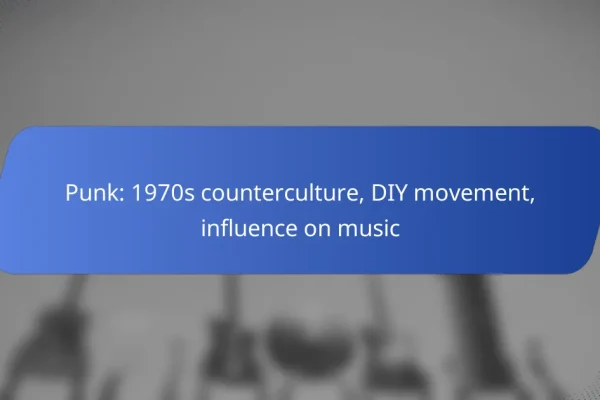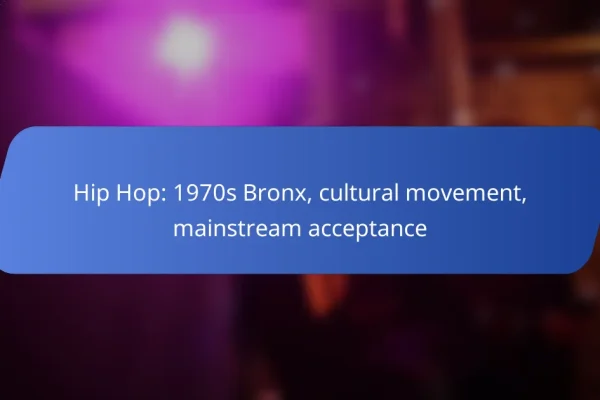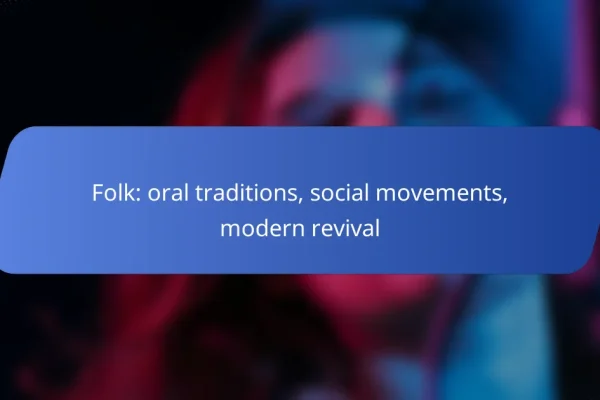How have music genres evolved in Australia?
Music genres in Australia have evolved through a blend of Indigenous traditions, colonial influences, and the emergence of unique styles like rock. This evolution reflects the country’s diverse cultural landscape and historical context.
Influence of Indigenous music
Indigenous music in Australia is characterized by its deep connection to the land and spirituality. Traditional instruments, such as the didgeridoo and clapsticks, play a vital role in ceremonies and storytelling, influencing contemporary Australian music.
Many modern Australian artists incorporate Indigenous elements into their music, creating a fusion that respects and honors these traditions. This blending enriches the musical landscape and promotes cultural awareness.
Impact of British colonization
The arrival of British settlers in the 18th century introduced European musical styles to Australia, significantly shaping the country’s music scene. Folk songs, ballads, and classical music began to intermingle with Indigenous sounds, leading to a unique cultural synthesis.
As Australia developed, genres such as bush ballads emerged, reflecting the experiences of rural life and the Australian identity. This period laid the groundwork for future musical innovations and the growth of various genres.
Emergence of Australian rock
Australian rock began to gain prominence in the 1960s, influenced by global rock movements while developing its distinct sound. Bands like The Easybeats and later AC/DC and INXS contributed to a vibrant rock scene that resonated both locally and internationally.
This genre has continued to evolve, with contemporary artists blending rock with pop, punk, and alternative influences. The Australian rock scene remains a significant part of the country’s cultural identity, showcasing its musical diversity and creativity.
What are the major music genres in Australia?
Australia boasts a diverse music scene that includes several major genres such as pop, country, and hip-hop. Each genre has its unique characteristics and varying levels of popularity across different demographics.
Pop music trends
Pop music in Australia is characterized by catchy melodies and relatable lyrics, often reflecting contemporary themes. Artists like Tones and I and The Kid LAROI have gained international recognition, showcasing the global appeal of Australian pop.
Current trends include the blending of pop with electronic and indie influences, creating a vibrant soundscape. Streaming platforms have significantly impacted how pop music is consumed, with many artists leveraging social media for promotion and fan engagement.
Country music popularity
Country music enjoys a dedicated following in Australia, particularly in rural areas and among older demographics. Festivals like the Tamworth Country Music Festival highlight the genre’s significance, attracting thousands of fans each year.
Australian country music often incorporates local stories and landscapes, distinguishing it from its American counterpart. Artists such as Keith Urban and Kasey Chambers have played a crucial role in popularizing the genre both domestically and internationally.
Hip-hop scene growth
The hip-hop scene in Australia has experienced significant growth over the past decade, with a surge in local talent gaining recognition. Artists like Hilltop Hoods and Sampa the Great have contributed to a vibrant and diverse hip-hop culture.
This genre often addresses social issues and personal experiences, resonating with a wide audience. The rise of online platforms has facilitated the discovery of new artists, making it easier for them to reach fans and collaborate across genres.
How do music genres influence Australian culture?
Music genres significantly shape Australian culture by reflecting the diverse backgrounds and experiences of its people. They serve as a medium for expressing social issues, celebrating heritage, and fostering community connections.
Reflection of societal changes
Music genres often mirror the evolving societal landscape in Australia. For instance, genres like hip-hop and punk have emerged as powerful voices for youth, addressing topics such as inequality and identity. As societal values shift, so too do the themes and styles within these genres, showcasing the dynamic nature of Australian culture.
Additionally, the rise of Indigenous music genres has highlighted the importance of reconciliation and cultural awareness. Artists like Gurrumul and The Kid LAROI have brought Indigenous stories and perspectives to mainstream audiences, fostering greater appreciation for Australia’s rich cultural tapestry.
Role in community identity
Music genres play a crucial role in shaping community identity across Australia. Local scenes often develop around specific genres, such as country music in rural areas or electronic music in urban centers. These genres create a sense of belonging and pride among community members.
Festivals and events centered on particular music styles, like the Tamworth Country Music Festival, reinforce these identities by bringing people together to celebrate their shared passions. Such gatherings not only promote local talent but also strengthen social bonds within communities.
What are the key characteristics of Australian music genres?
Australian music genres are distinguished by their unique blend of cultural influences, instrumentation, and lyrical content. They often reflect the diverse backgrounds of the artists and the rich history of the country.
Instrumentation and style
Instrumentation in Australian music varies widely, often incorporating traditional instruments alongside modern ones. Genres like country music may feature guitars and banjos, while Indigenous music prominently uses didgeridoos and clapsticks.
The style of Australian music genres can range from folk and rock to electronic and hip-hop, each showcasing distinct sounds and rhythms. For instance, Australian rock often emphasizes strong guitar riffs and anthemic choruses, while electronic music may focus on synthesized sounds and beats.
Lyrical themes
Lyrical themes in Australian music frequently explore identity, landscape, and social issues. Many songs reflect the connection to the Australian environment, celebrating its natural beauty or addressing challenges faced by communities.
Additionally, themes of resilience and cultural heritage are common, particularly in Indigenous music, which often tells stories of ancestral history and connection to the land. This rich tapestry of themes contributes to the depth and variety found in Australian music genres.
What are the emerging trends in music genres?
Emerging trends in music genres include the blending of styles, the impact of digital platforms, and the influence of global sounds on local music. These trends reflect the evolving landscape of music consumption and production, driven by technology and cultural exchange.
Fusion of genres
The fusion of genres involves combining elements from different musical styles to create new sounds. This trend has led to innovative sub-genres, such as country rap and jazz-hop, which appeal to diverse audiences. Artists are increasingly experimenting with cross-genre collaborations, resulting in unique tracks that challenge traditional genre boundaries.
For musicians, embracing genre fusion can broaden their appeal and attract listeners from various backgrounds. However, it is essential to maintain a coherent sound to avoid alienating core fans. Successful examples include collaborations between pop and electronic music artists, which have dominated charts worldwide.
Rise of digital platforms
Digital platforms have revolutionized how music is distributed and consumed, allowing independent artists to reach global audiences without traditional gatekeepers. Streaming services like Spotify and Apple Music have become primary sources for music discovery, influencing genre popularity and trends. Artists can now analyze listener data to tailor their music and marketing strategies effectively.
While digital platforms provide opportunities, they also create challenges, such as intense competition and the need for effective online promotion. Artists should focus on building a strong online presence and engaging with their audience through social media to stand out in a crowded market.
Global influences on local music
Global influences are reshaping local music scenes, as artists incorporate sounds and styles from around the world. This trend is evident in genres like reggaeton, which blends Latin rhythms with hip-hop and dancehall, creating a global phenomenon. Local musicians are increasingly drawing inspiration from international trends, leading to a rich tapestry of sounds.
For artists, embracing global influences can enhance creativity and expand their audience. However, it’s crucial to respect cultural origins and avoid appropriation. Collaborating with artists from different backgrounds can foster authenticity and create a more genuine fusion of sounds.
How does technology impact music genre evolution?
Technology significantly influences the evolution of music genres by enabling new sounds, production techniques, and distribution methods. Innovations such as digital audio workstations, synthesizers, and streaming platforms have transformed how music is created and consumed, leading to the emergence of diverse genres.
The role of digital audio technology
Digital audio technology has revolutionized music production, allowing artists to experiment with sounds and styles that were previously difficult or impossible to achieve. Tools like MIDI controllers and software synthesizers enable musicians to create intricate compositions without the need for expensive studio equipment.
For example, genres like electronic dance music (EDM) and hip-hop have thrived due to accessible digital tools, allowing producers to manipulate sounds and samples creatively. This democratization of music production has led to a surge in genre-blending and innovation.
Impact of streaming services
Streaming services have reshaped how music is distributed and consumed, affecting genre popularity and accessibility. Platforms like Spotify and Apple Music allow listeners to explore a vast array of genres, often leading to the discovery of niche styles that may not have gained traction through traditional media.
As a result, artists can reach global audiences without the backing of major labels, fostering the growth of genres such as lo-fi hip-hop and indie pop. This shift encourages genre experimentation, as musicians can easily share their work and receive feedback from diverse listeners.
Social media and genre promotion
Social media platforms play a crucial role in promoting new music genres and connecting artists with fans. Platforms like TikTok and Instagram enable users to share snippets of songs, often leading to viral trends that can propel a genre into the mainstream.
For instance, the rise of bedroom pop can be attributed to artists sharing their music on social media, creating a direct line of communication with their audience. This grassroots promotion allows for rapid genre evolution as artists respond to trends and listener preferences in real-time.




